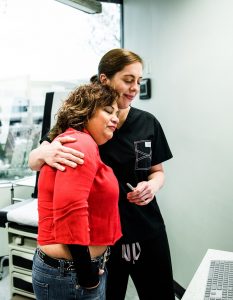 With the advancement of breast reconstruction techniques, more often than not, reconstruction is done in multiple stages and over a period of time. In other words, breast revision surgeries may be necessary – not because of a poor cosmetic result but because individual reconstruction is based on a case-by-case plan and may require multiple staging. Other patients may seek breast revisions due to dissatisfaction or poor outcome of their current breast reconstruction, and still others will undergo revisions to correct abnormalities revealed over time as the body naturally ages.
With the advancement of breast reconstruction techniques, more often than not, reconstruction is done in multiple stages and over a period of time. In other words, breast revision surgeries may be necessary – not because of a poor cosmetic result but because individual reconstruction is based on a case-by-case plan and may require multiple staging. Other patients may seek breast revisions due to dissatisfaction or poor outcome of their current breast reconstruction, and still others will undergo revisions to correct abnormalities revealed over time as the body naturally ages.
Depending upon a patient’s diagnosis and individual treatment case, reconstruction circumstances may play a role in the likelihood of revision surgery. For example, if a patient opts for a unilateral mastectomy and reconstruction, the healthy, unaffected breast – still naturally aging – may need to be lifted eventually for a more pleasing aesthetic result. Likewise, a patient undergoing radiation may notice changes in shape and/or positioning of the affected breast.
After the placement of implants, a patient may seek revision s urgery due to unhappiness regarding size. If a patient experiences additional problems after reconstruction such as capsular contracture, displacement and/or other abnormalities, implants may also need to be removed and/or corrected. And, as is the case with elected breast enhancement surgeries, implants used in the breast reconstruction process also have a “shelf life.” The FDA recommends replacement every twelve years.
urgery due to unhappiness regarding size. If a patient experiences additional problems after reconstruction such as capsular contracture, displacement and/or other abnormalities, implants may also need to be removed and/or corrected. And, as is the case with elected breast enhancement surgeries, implants used in the breast reconstruction process also have a “shelf life.” The FDA recommends replacement every twelve years.
A poor cosmetic result may lead to revision surgery. Sometimes, with a particularly difficult case of reconstruction, the primary surgery is not expected to achieve the final outcome. In other cases, patients may elect revision surgeries to address poor results due to less experienced surgeons.
With invasive surgeries like mastectomies, excess scarring is possible. Internal scar tissue may result in an unnatural, and often uncomfortable, hard feeling in the breast. Visible aesthetic scarring, resulting from both implants and the DIEP procedure, can also be addressed with revision surgery.
Radiation treatment may cause noticeable changes to breast tissue. Skin may tighten, feel firmer and become less elastic; breast tissue may shrink; the affected breast may appear higher in position and patients may experience decreased blood circulation.
 HOW ARE ISSUES CORRECTED?
HOW ARE ISSUES CORRECTED?
Medical and aesthetic abnormalities can be addressed with multiple procedures:
Symmetry issues can be addressed with breast reduction, breast lift and/or breast augmentation. Fat grafting – the harvesting of fat from one area of the body to be injected into the breast – improves shape and contour after implants or DIEP. This procedure is also used to correct abnormalities associated with lumpectomy and/or radiation.
Tissue rearrangement improves breast shape, position, and/or size. It is often performed as a later stage of reconstruction to refine results.
An implant exchange is performed in cases of ruptured or leaking implants, capsular contracture, replacement due to normal implant “shelf life,” or to address concerns of size and/or positioning. New implant placement is most commonly performed for augmentation purposes and/or asymmetry correction.